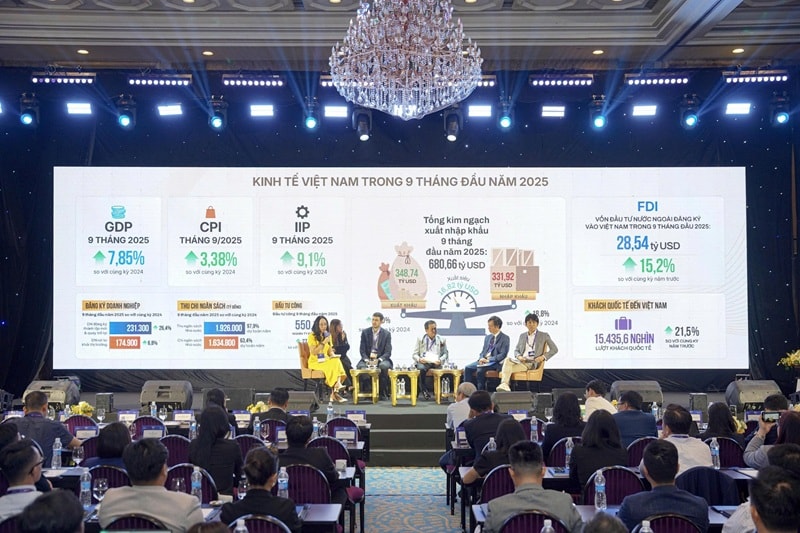Key drivers for Vietnam’s high GDP growth in 2026
As global economic conditions remain uncertain, experts predict that Vietnam’s internal strengths, domestic resilience, and the ongoing global monetary easing trend will support its strong GDP growth in 2026.

A resilient economy amid global headwinds
By the end of the third quarter of 2025, Vietnam’s economy had shown remarkable resilience despite a range of external challenges — global macroeconomic volatility, rising tariffs, currency risks, and soaring gold prices. According to Ms. Trinh Quynh Giao, CEO of PVI Asset Management (PVIAM), Vietnam’s macroeconomic indicators remain stable, inflation is under control, and industrial production continues to recover. Despite earlier concerns that U.S. tariffs could divert foreign direct investment (FDI) flows away from Vietnam, both registered and disbursed FDI have continued to grow, reflecting sustained investor confidence in the country’s stability.
At the Vietnam Investment Forum 2026 (VIF), held on November 4, 2025, in Ho Chi Minh City by VietnamBiz and Vietnam Moi, Dr. Le Duy Binh, Director of Economica Vietnam, noted that to understand 2026, one must first look back at the past five years. “We’ve gone through some very difficult times — both internally and externally — from the pandemic to subsequent global economic shocks. Yet Vietnam has consistently managed to bounce back,” he said.
According to Dr. Binh, Vietnam has previously achieved growth rates exceeding 8%, and in recent years maintained between 6.5% and 7%. “This demonstrates that the economy’s internal strength has significantly improved,” he added.
He emphasized that macroeconomic stability, political stability, and strong consumer and investor confidence — both domestic and international — form a solid foundation for optimism in 2026 and beyond. “I won’t comment on double-digit growth figures, but I believe this year’s GDP will surpass last year’s, and 2026 will be even stronger.”
Vietnam’s economy remains deeply intertwined with global trade, yet exports and imports have reached new records. Despite sluggish global recovery, total trade turnover is projected to hit USD 800–850 billion, an all-time high — underscoring Vietnam’s reputation as a reliable manufacturing hub.
Fiscal and investment momentum
Public investment is expected to continue playing a key role in growth. “This year’s disbursement rate will likely exceed last year’s, providing new room for development,” said Dr. Binh. With stable fiscal revenues and public debt well below the ceiling, Vietnam can maintain — or even accelerate — public investment in 2026.
He also highlighted the revival of private and FDI investment, particularly after the adoption of Resolution 68, which has boosted business confidence. Legal bottlenecks are being cleared, FDI disbursement is increasing, and more private firms are returning to operation. “These are strong signals that private investment is rebounding,” he said.
Domestic consumption has also been robust, with retail and service revenues growing between 9–11% despite economic headwinds. “Vietnam’s market of 100 million people is the second or third largest in Southeast Asia and ranks 15th globally. Rising disposable incomes and macroeconomic stability will continue to support domestic demand,” Dr. Binh added.
However, he cautioned that future growth depends on managing key risks — monetary policy, inflation, and debt — and on reducing Vietnam’s reliance on credit- and capital-intensive growth models.
Dr. Le Anh Tuan, CEO of Dragon Capital, projected that Vietnam’s GDP could grow above 10% in 2026, guided by the principle: “Stay optimistic, act prudently.”
He noted that inflation risks remain low since consumption has not yet surged, and that while monetary policy faces constraints due to exchange rate pressures, “as long as the exchange rate stays stable, monetary policy should continue to follow an easing trend.”
Vietnam’s economy, he explained, remains relatively dollarized, with large reserves of foreign currency and gold, making exchange rate stability critical to interest rate policy.

Experts said Vietnam still retains a competitive position compared to China and India, remaining a key assembly and export hub for the U.S. market.
Mr. Sacha Dray, Economist at the World Bank in Vietnam, agreed that Vietnam’s economy is showing “very positive and strong progress.” He highlighted that business registrations rose 8.2% year-on-year, the fastest growth in the region. Export volumes to the U.S. reached USD 113 billion, up 23% year-on-year, marking a new record in Vietnam’s trade history.
However, Dray also noted that U.S. tariffs have raised export and import costs — with American buyers bearing about 51% of the increase and Vietnamese exporters about 49%. Nevertheless, Vietnam still retains a competitive position compared to China and India, remaining a key assembly and export hub for the U.S. market.
He added that strong government support policies have helped businesses navigate uncertainty, restore trade relationships, and strengthen export recovery. The World Bank economist also urged Vietnam to better leverage its network of free trade agreements (FTAs) to optimize export potential and domestic value addition.
Private sector: Ready to lead
From the private sector’s perspective, Mr. Dang Van Thanh, Chairman of TTC Group, said that while public investment will remain a temporary growth driver, sustainable development depends on the private sector’s ability to seize opportunities from bilateral and multilateral agreements.
“2025 marks both an end and a beginning — we are entering a new cycle. No one can predict the exact USD exchange rate or interest rate next year, but one thing is certain: every 10, 15, or 50 years, the cycle restarts. This is a 50-year cycle. Those who fail to adapt will be eliminated. The core of business lies in management, control, and execution,” Mr. Thanh stated.
He expressed optimism that Vietnamese firms would eventually “inherit” and localize the benefits of FDI once domestic capacity matures. He also proposed consumer stimulus measures — from VAT cuts to retail vouchers — to boost domestic demand.
Concluding the forum, Ms. Trinh Quynh Giao summarized Vietnam’s economic outlook for 2026 in three words: “Confidence – Mission – Action.”








